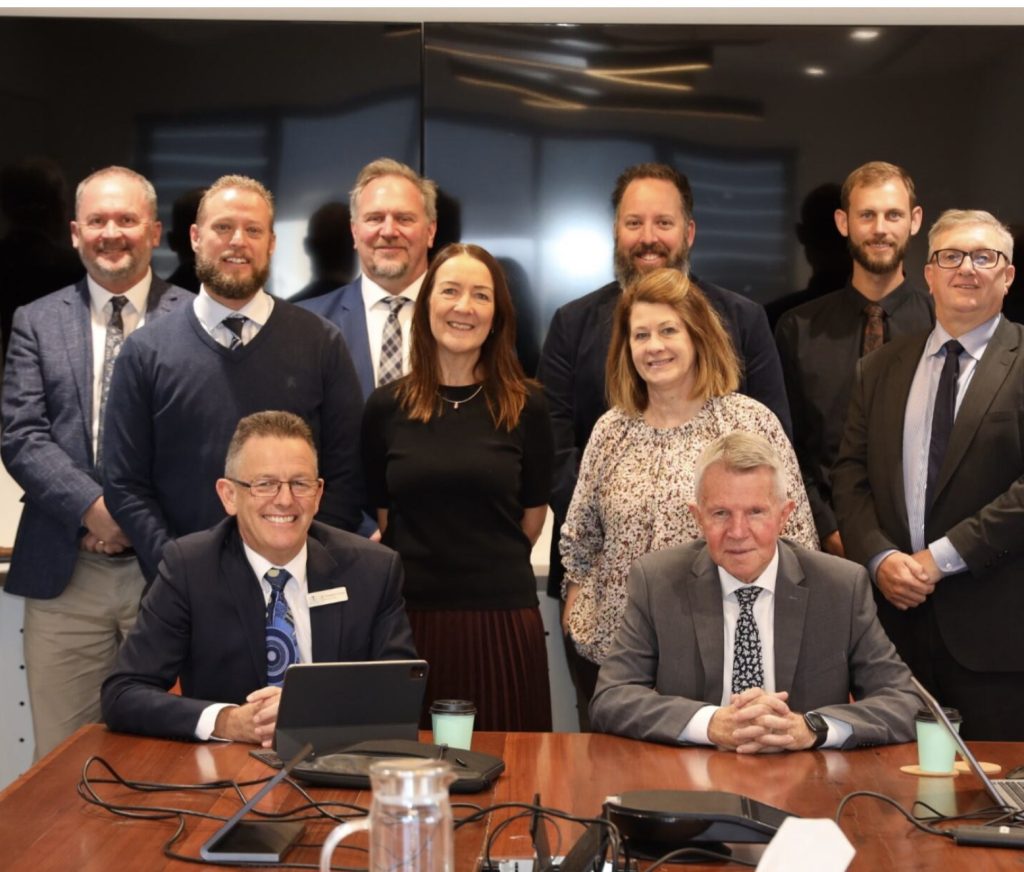In May 2024, a team from SCEA travelled to Canberra for the National Policy Forum, stopping to visit the Head Office of St Philip’s Christian College (SPCC) in Newcastle along the way.
During the visit, Mr Graeme Irwin, CEO of SPCC, shared valuable insights about initiatives underway at St Philip’s. Some of these are helping SCEA to refine and improve its services and operations under our new COO, Mr Nick Wood.
One standout was how the SPCC head office uses a ‘wheel’ graphic to communicate progress being made on their new initiatives for each school term. This simple yet effective tool helps keep everyone at SPCC informed and engaged.

Inspired by this, SCEA is now working on its own improvement plans, which will form part of a new five-year Strategic Plan that will shortly be developed. To keep everyone at SCEA informed about these improvement plans and when new initiatives are planned for implementation, we are looking to adopt a similar communication approach.
Below is an example of our ‘Strategy Wheel’ showing key initiatives across the Head Office teams that are planned for Term 3:

“It seems an opportune time to be creating the SCEA Wheel,” said Mr Nick Wood this week.
Mr Nick Wood emphasised the importance of clear and consistent communication. “If we want to build trust and engagement across SCEA, we need to be transparent about what we’re doing and share the right information at the right time.”
For head office staff, this provides clarity on where their attention and efforts need to be concentrated. And for our staff in Schools, knowing what’s in the pipeline will build awareness about what’s coming and how it will benefit them.”
Dr Graeme Cross (Chief Executive Officer – SCEA) has been delighted with this new concept, particularly because it has been successfully used in a school system similar to SCEA for a period of time.
“Our interactions with St Philip’s and Mr Graeme Irwin are always fruitful. Their work in this area, along with their focus on training undergraduate teachers and in developing leadership qualities at each level of the organisation, is admirable.”
“Our hope is that this will bring even greater levels of transparency and clarity to our planning and change management processes.”
For each department, a set of strategic outcomes is formulated, and then the Strategy Wheel is constructed to determine timelines and priorities. An example of the ICT strategic outcomes is shown below:
| ICT STRATEGIC OUTCOMES 2024-25 |
|---|
| INFRASTRUCTURE REFRESH (ALL SCHOOLS): PHASE 1: New Phone System: better features and greater capacity to meet our growing needs. Upgraded Network & Wi-Fi: seamless connectivity and faster network speeds for everyone. Internet Safety: improved filtering for safer online access that can be tailoured to users (e.g. different age groups). New Printers: replacing unreliable and cost inefficient units with updated models. PHASE 2: Video Conferencing: modern facilities for online collaboration that better support end user communication requirements. New Servers & Storage: reliable and secure data services. Enhanced PA Systems: better public address and emergency announcement capability. PHASE 3: Classroom Tech: standardised and modern audiovisual equipment, whiteboards, and screens. Security Upgrades: high quality and consistent security cameras and vape sensors. ONGOING SECURITY PROGRAM: Multi-Factor Authentication: added cyber protection for staff logins. Phishing Tests & Training: improving staff awareness and vigilance around social engineering threats and scam emails. Microsoft A5 Licensing: enhanced virus, cyber security, and data protection. Security Monitoring: continuous system and data protection, 24/7/365. Compliance: working towards Essential Eight Australian security standards. STAFF AND STUDENT DEVICE PROGRAM: Vendor Selection: choosing a Supply Partner to provide a cost-effective common device platform for SCEA staff and students. Transition Plan: timeline for moving away from BYOD to school-managed common devices. Preparations and Pilots: technical setup and training ahead of selected school pilots of the new common device platform. Training: professional learning, capacity building, and technical support provided to staff to enable the adoption of new common devices. These initiatives aim to modernise the digital technologies supporting our schools to deliver greater value, improve cybersecurity, and ensure safe and reliable access for everyone. |
The ICT Strategy Wheel that determines timelines and priorities is shown below:

With the advent of the ‘Strategy Wheel’ at SCEA, Head Office has been buzzing this month with ‘wheel-y’ good puns, with Mr Rhys Vallance, Head of Risk & Compliance, contributing a number of jocular gags at morning devotions on Tuesday.
“Wheel have to see whether this gets me motivated to roll on with my projects – it’s a little early in the day to be reinventing the wheel.”
Eye-roll.
“This conversation keeps going round and round in circles,” said Dr Gregg Weaver (Chief Education Officer – SCEA).
Groan.
“I never get tyred of these puns!” concluded Mr Vallance.
Apologies to all of you who feel that these comments are driving you nuts – some of them fell a bit flat!


